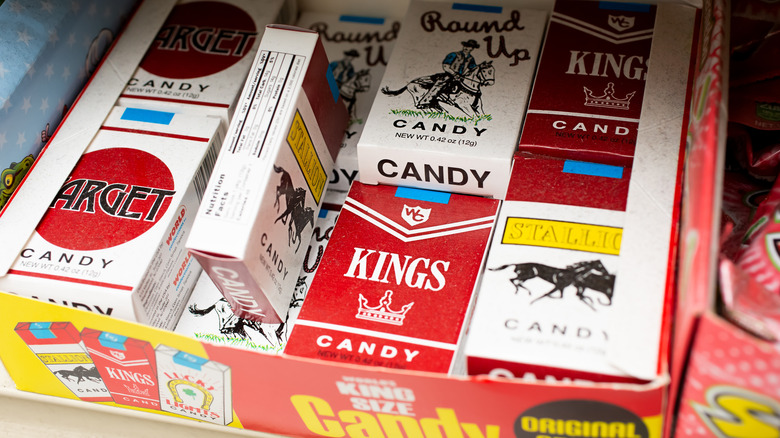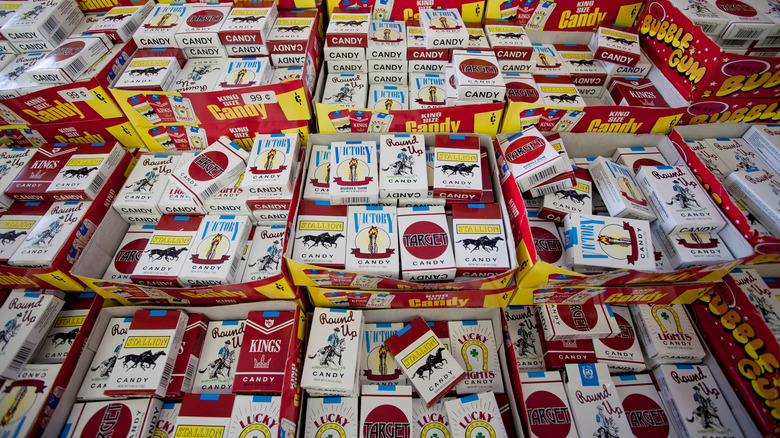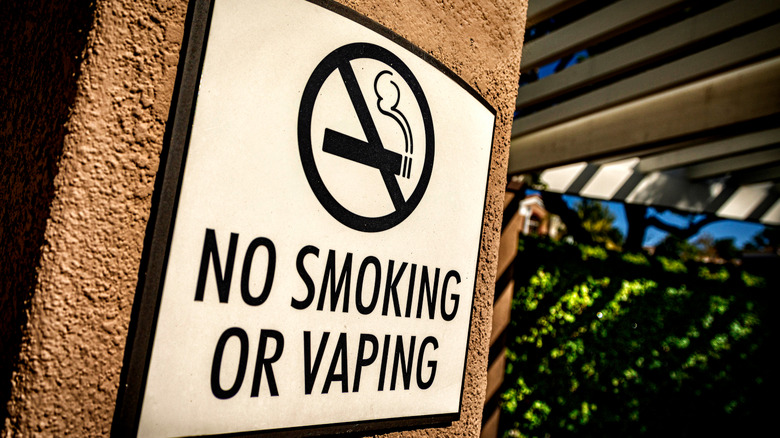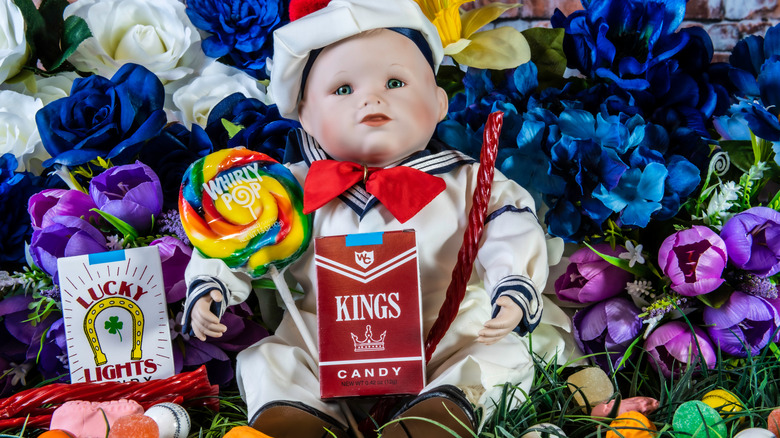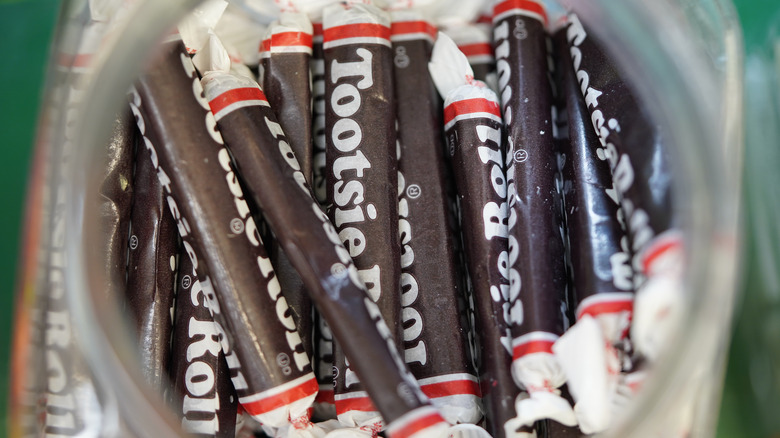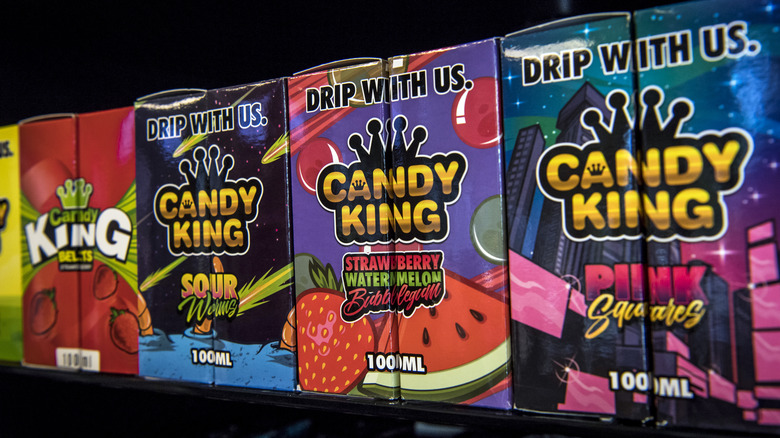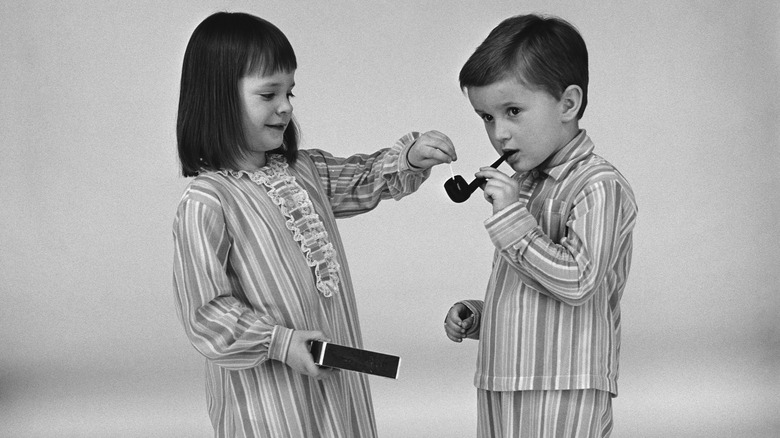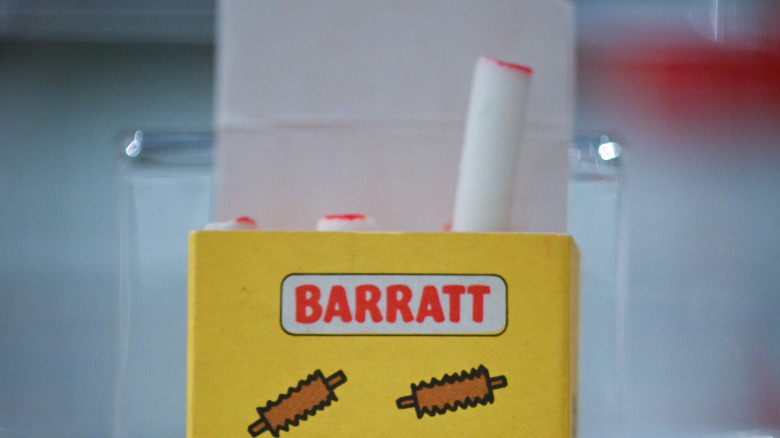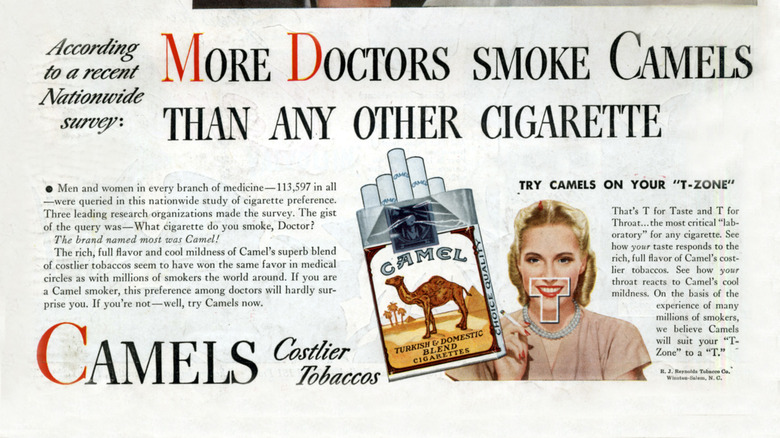Whatever Happened To Candy Cigarettes?
Looking back on your younger years can be a pleasant way to spend time, but if you look closely, you'll find a lot of the things that you considered normal are things that just wouldn't fly now. One of these is the candy cigarette, along with its sibling, the bubblegum cigarette. These sticks of compressed sugar let you mimic a relative, movie star, or another adult whose image was closely linked to holding a paper-wrapped column of tobacco. While the candy didn't last long once you started smoking it, often dissolving as you held it in your mouth, it let you pretend that you were that cool-as-cucumber adult when you weren't yet out of elementary school.
But, like many things from your childhood, the candy cigs likely faded into a distant memory. Maybe you moved on to real cigarettes or gave the candy up when you decided in high school that it looked too childish. Then, you suddenly came across a reminder of these packs you used to buy from convenience stores and realized that you haven't seen the candy in years. So, whatever happened to those candy cigarettes?
Candy cigarettes are still around, just without the cigarette designation
First of all, candy cigarettes are alive and well, just without the word "cigarette" attached to them. You can still buy fairly realistic packs of the cigarettes, and they're easy to recognize even without that word displayed on the packaging anymore. They may call themselves "sticks" or something similar, but the graphics on the package are unmistakable. You'll find them either online or in stores that carry novelty and seasonal candies, as well as in a few supermarkets.
You'll also find a couple of differences regarding how they're formed. For example, candy cigarettes no longer have the red dot at the end that made you look like you were inhaling and drawing in "smoke," and gum cigarettes no longer have the powdered sugar you could blow out to mimic smoke. The cigarettes are sold through smaller companies that aren't always that easy to contact. The lack of communication is likely a survival strategy. Companies want you to know the candy exists but aren't too keen to be in the spotlight themselves, where they might attract the attention of people trying to ban their products. This doesn't always work out, as any connection between children and tobacco shines a light right back on these companies, such as when a child on the "Toddlers and Tiaras" reality show was filmed in a smoking pose in 2012. While the child was using a prop, media attention once again landed on candy cigarette distributors.
The increased opposition to smoking is the real culprit behind the candy's decline in popularity
The main reason for candy cigarettes becoming much less popular and much harder to find is the transformation of smoking from a harmless social habit to something that's seen as incredibly harmful to both the smoker and those around them. There's no real doubt now that smoking is linked to a host of diseases, and it's not something that most people want to promote to kids, who have historically been the target demographic for candy cigarettes. After the Surgeon General's 1964 report about the link between bad health and tobacco came out, the tobacco industry began a long, slow slide into uncoolness that took candy cigarettes along for the ride.
That's not to say companies didn't put up a fight. While candy cigarettes were produced by companies other than those run by the tobacco industry, cigarette manufacturers were determined to help those products stay available. They influenced government officials to overturn or oppose bans and other restrictions, though that influence waned over the decades. By the 1970s, even those failed government restrictions managed to have some effect. One attempt at a nationwide ban, for example, failed in its main goal but made candy companies realize that their products were in the government's sights. As a result, they started making changes like removing "cigarettes" from labels.
Repeated studies showed a connection between candy cigarettes and smoking real cigarettes
Adding to the opposition against candy cigarettes were revelations that people who used candy cigarettes were more likely to transition to smoking real cigarettes and that smokers were more likely than nonsmokers to grab a candy cigarette. Evidence came out that studies with negative results were hidden and that kids were "desensitized" to smoking through consumption of the candy, according to the Journal of Pediatrics. All in all, the science doesn't look good for candy cigarettes.
On one hand, that seems obvious. These things are candy, they're pure sugar, and they essentially train kids in how to act when holding a cigarette. But for decades, the candy cigarettes were seen as harmless fun. The candy was a prop that kids could use to play act, and the doom and gloom presented by those who opposed the candy were seen as far-fetched. Even though proof was finally available that smoking was terrible for your health, smoking was still so popular in the latter half of the 20th century that it was probably hard for many to see how using this candy could lead to more people taking up smoking and harming themselves. The opposition brought about by the research took years to solidify into an influential movement.
Several cities and states have tried to ban the candy
Those who objected to candy cigarettes didn't wait for research to back them up; they started trying to ban sales of the candy early on. But, fighting against the tobacco industry was hard and most of these bans didn't succeed.
Probably the most eye-rolling argument against a ban had to do with Tootsie Rolls. Back in 1971, the state of New York decided a ban on candy cigarettes and other candy versions of tobacco products would be a sensible idea. The proposed ban encountered resistance as you'd expect, but the argument that finally tanked the proposal claimed that the ban would target anything resembling a tobacco product, meaning tube-shaped candy like Tootsie Rolls could end up being banned. It's true that if the ban were worded terribly it could conceivably be extended to other products, even if those products were clearly not supposed to represent tobacco. Rather than ensure the proposed ban excluded items that weren't clear representations of tobacco products, the state decided to scrap the attempt at a ban altogether.
Some cities and states in the U.S. actually succeeded with a ban
Despite staunch opposition from the tobacco and candy industries, some of these bans have actually made it into law in the U.S. The most notable was in North Dakota, which managed to ban the sale of candy cigarettes statewide from 1953 to 1967. Since then, both Maine and Tennessee have banned candy cigarettes, and those bans are still in force. The city of St. Paul, Minnesota, also has a local ban on selling the products.
The U.S. has tried a couple of times to ban candy cigarettes nationwide, but neither attempt was successful. If you've heard that the country banned candy cigarettes in 2009 as part of the Family Smoking Prevention and Tobacco Control Act, that information isn't correct and is based on a misunderstanding. The act bans candy-flavored cigarettes along with fruit- and clove-flavored cigs, but not candy meant to resemble a cigarette. Attention remains more focused on flavored tobacco and e-cigarettes/vapes now than on candy cigarettes, with bans targeting those products currently in discussion.
Some countries have completely banned the candy
The U.S. may not have banned candy cigarettes nationwide, but so far, at least 25 other countries have managed to place a partial or total ban on sales. Nations from Turkey and Saudi Arabia to Ireland and Norway no longer allow the candy to be sold, and the fact that they've been able to institute these bans has placed more pressure on the U.S. to join them.
This doesn't mean that every ban is totally successful. In Australia, where the state of New South Wales banned cigarette candy (or "confectionary cigarettes") in 1999, a brand of chocolate cigarettes showed up in stores in 2008. The distribution company's owner told the Sydney Morning Herald that wholesalers in other states may have sent the cigarettes to stores in New South Wales in error after his company stopped importing the brand. Moreover, another brand of candy cigarette currently called Fads continues to be legal in New South Wales after only a product name change.
Congress banned commercials advertising cigarettes
Another signpost on the road to obscurity for candy cigarettes was the banning of cigarette advertising on television in the early 1970s. While this ban focused on tobacco, it was another way to remove cigarettes from the view of kids and teens. None of this advertising, either of tobacco or of candy, was meant to work in isolation. Cigarette advertising was everywhere, so kids saw it on TV, on billboards, in magazines, and, conveniently, in the graphics on packs of candy cigarettes. Taking away the ability of tobacco companies to advertise during commercial breaks meant that the companies' reach was now shrinking.
Tobacco companies complied — technically speaking. They stopped having broadcast commercials for cigarettes, but they continued to do things like have billboard advertising at televised sports events. Over time, more restrictions on tobacco advertising were put in place, especially after the 1998 Master Settlement Agreement (MSA). This was the huge settlement between tobacco companies and U.S. states and territories regarding treatment costs. The MSA severely restricted the ability to market tobacco to young people by prohibiting sponsorships, cartoon advertising, and more. The agreement didn't ban candy cigarettes, but it so greatly reduced the visibility of tobacco (after public pressure on tobacco companies to comply with the agreement, which is another story) that the image of tobacco as something cool to be mimicked with candy waned even more.
The target audience has grown up
Tobacco companies weren't thrilled at first when candy companies started copying their logos and package designs to sell candy cigarettes, but eventually, the tobacco companies realized that these candies were actually pretty good ads. If kids bought the candy cigarettes and saw packaging that looked like the real thing, that could get them interested in using the tobacco version when they were older. Kids were targeted as future smokers who would continue to provide business for the tobacco companies as older smokers died. R.J. Reynolds (which represents brands including Newport and Camel) actually called them "replacement smokers," according to UCSF Library of Industry Documents. A partnership was born, and candy cigarettes with their spoofed brand names got the backing of some of the country's biggest cigarette manufacturers.
That target audience has grown up, and while many did go on to use tobacco, others didn't. The people most interested in candy cigarettes have long left them behind, except when indulging in an occasional memory. As this population gets older, it'll naturally grow smaller, further reducing the demand for candy cigarettes.
Current marketing still targets those who smoked decades ago
If you want your product to be noticed, you need to advertise. If you want a specific demographic to use your product, you have to target your advertising to that demographic. Herein lies another reason why candy cigarettes are no longer so common: They're no longer marketed to kids, major retailers just don't sell them anymore, and current marketing is aimed at nostalgia in adults. It's a limited consumer base consisting mainly of adults cosplaying people from earlier decades when carrying a cigarette was de rigueur.
Buyers were likely people who had been kids in the 1950s through the 1970s and who were just recalling a childhood memory. That's likely not too far off from the truth as the enthusiastic reactions you read about online often aren't from children, but rather from adults who remember the candy from their childhood.
Kids today don't have the same associations around smoking
One of the more subtle but very influential causes behind the reduction in the popularity of candy cigarettes is the fact that kids today don't have the same associations regarding smoking. While smokers still exist, obviously, smoking itself is no longer seen as glamorous or something that everyone just does. A recent Gallup poll showed that the percentage of U.S. adults who admit to smoking has steadily declined since the 1940s and 1950s and has dropped sharply since the beginning of the 21st century. 45% of adults smoked in 1954, while only 12% smoked in 2023.
Most adults view tobacco cigarettes as harmful now, and that's led to fewer smokers as role models and fewer families where smoking is deemed okay. Kids are no longer told that if they use candy cigarettes, they'll be just like their parents, and unless they have a penchant for watching films from decades ago, they're not seeing cigarettes consistently used by main characters. Thrillist writer Adam K. Raymond recalled that when he let his toddler try a candy cigarette, she handed it back. He wrote that while that could have been due to the taste, it might also have been because she didn't have the same view of cigarettes as forbidden and tempting. As a result, more kids no longer see holding a tobacco cigarette as an "adult" thing to do, and candy cigarettes aren't seen as a way to seem like an adult.
They're still shocking consumers
Talk to any baby boomer, Gen Xer, or millennial and chances are they bought candy and gum cigarettes as kids. And, chances are they can remember the gum and candy in detail, down to the gum's powdered-sugar "smoke" and the haphazard red dye at the end of the candy version — that's how common the cigarettes were. Yet, the continued existence of the candy, even with some cosmetic and branding changes, can still shock former consumers and make them worry about the effects on kids today.
For example, when WMAZ reported that a local market had been selling candy cigarettes in 2020, they interviewed a man who remembered the cigarettes from his childhood but still worried that they could serve as "validation" to children that smoking was okay. Writing on the website for radio station 95.3 "The Bear" in Alabama, Scott Shepherd noted that he "couldn't imagine my kids rockin [sic] a pack today." Reddit is filled with surprised posts about the candies still existing and how strange it is that they were so normalized for so long. One Redditor didn't hold back when recalling the cigarettes, writing, "Holy hell, these things were/are plain evil."
Opposition to candy cigarettes isn't new and once tried to connect the candy to gambling and alcohol
Criticism of candy cigarettes isn't new. While current opposition may be based in science and studies that track tobacco use, previous objections focused on how candy cigarettes would corrupt youth and lead them to partake in all sorts of antisocial behaviors. From claims that the candy would make children smoke actual cigarettes (which wasn't that far off, considering later research) or turn them into alcoholics, candy cigarettes were treated as a threat to children's well-being. One claim correlated candy cigarette use with gambling because having their own money to purchase the candy almost certainly meant that children would start acting like adults in other ways, including taking on any and all vices that adults had.
Opposition cooled somewhat, at least in the media, as the tobacco industry gathered doctors into its arms. The Ladies Home Journal, for example, claimed in 1906 that once a child used a candy cigarette, it was only a short, slippery slope to using excess salt, caffeine, tobacco, and alcohol. By the 1940s, the Journal was running tobacco company ads touting smooth flavors and doctor-recommended brands to its readers.
